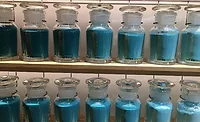What About Bismuth?
 Credit: Engelhard Corp.
Credit: Engelhard Corp.
Bismuth vanadate and bismuth vanadate/molybdate, basic bismuth nitrate and bismuth oxychloride all have been used as pigments. The Bi-V pigments are absorption pigments appearing yellow to red-orange. Since bismuth oxychloride (BiOCl) and basic bismuth nitrate (BiONO3.H2O) are both white and can be grown as platelets, they can be pearlescent. Bismuth nitrate tends to recrystallize, leading to loss of pearlescence, and has not found significant application. Therefore, our interest is limited to bismuth oxychloride.
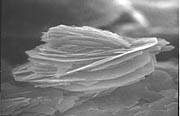 Credit: Engelhard Corp.
Credit: Engelhard Corp.Evolution of Bismuth Oxychloride as a Pigment
Bismuth oxychloride is routinely used in cosmetics because it has the global regulatory status of “approved color additive.” This gives cosmetic formulators great flexibility in using it as a white pigment/filler. Engelhard Corp.’s Mearlite® LBU™, shown as an electron micrograph, illustrates why bismuth oxychloride makes a good white pigment/filler. The rosette form of crystal growth contains thin platelets all growing at different angles; there is no smooth, well-defined surface. Its whiteness is due to its index of refraction, its transparency in the visible region and the irregular surfaces and edges that can scatter light.Bismuth oxychloride pigments also have been developed to provide pearlescent effects. There has always been motivation to develop synthetic forms of pearlescent pigments instead of relying on the natural pearl derived from fish scales. The requirement is a substance that does not absorb visible light and that can be grown in a platy form. Basic lead carbonate (2Pb(CO3).Pb(OH)2 ) was successfully grown in a flat, crystalline form and was the first synthetic pearlescent pigment. However, concerns over the effects of lead compounds drove development of crystals based on other chemistries, including bismuth oxychloride.
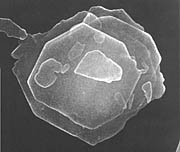 Credit: Engelhard Corp.
Credit: Engelhard Corp.It gives a slightly pearlescent effect and is less reflective than titanium dioxide-coated mica. The crystal is about 10 microns across.
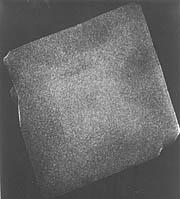 Credit: Engelhard Corp.
Credit: Engelhard Corp.The crystal is about 10 microns across and 0.07 microns thick.
All high grades of bismuth oxychloride crystals are formulated as pastes because of the tendency of the crystals to agglomerate face-to-face. These formulations are also adjusted so that the bismuth oxychloride, which is quite dense (specific gravity 7.7), does not hard pack, and the crystals are readily redispersed.
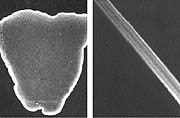 Credit: Engelhard Corp.
Credit: Engelhard Corp.Both platelets are about 10 microns across.
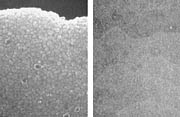 Credit: Engelhard Corp.
Credit: Engelhard Corp.Each micrograph is 1 to 2 microns across.
 Credit: Engelhard Corp.
Credit: Engelhard Corp.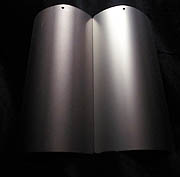 Credit: Engelhard Corp.
Credit: Engelhard Corp.Industrial Applications
Usage of bismuth oxychloride pigments evolved from applications where lead carbonate was the standard and mica-based pearlescents could not meet the desired level of brightness. Examples of these early end products include fishing lures, beads, cosmetic jewelry and buttons. This improved brightness, or luster, has also led to inroads where previously only aluminum pigments were used. Bismuth oxychloride pigments come closest to aluminum’s reflectance and have the benefit of being non-reactive when used in a waterborne system. In addition, their fine and extremely narrow particle size distribution has led to numerous opportunities in printing ink, where equipment parameters limit the size of the pigment. Engelhard’s bismuth oxychloride pigments are primarily provided as dispersions for specific coating or ink systems. The platelets are inherently very fragile and need proper wetting and dispersion to remain intact. However, dry forms of pearlescent bismuth oxychloride are available for the experienced formulator.Today there are numerous newer applications using bismuth oxychloride pigments. The trends toward smoothness and increased whiteness with a brighter finish have led to the surge in opportunities for bismuth oxychloride. The marble effect and the ability to create “veins” by simply stirring the dispersion in a medium have resulted in applications in solid surface markets such as countertops and spas. Bismuth pigments also can be found as base coatings within the many layers of transparent stains employed in wood finishing. Even the newest wave in writing utensils, the gel pen, could benefit from the brightness and metallic appearance of bismuth oxychloride pigments. Table 2 is intended as a basic guide for the most popular Engelhard pearlescent bismuth oxychloride products, sold under the Mearlite trademark.
 Credit: Engelhard Corp.
Credit: Engelhard Corp.Automotive Applications
In the 1980s, styling work with high-grade bismuth oxychloride indicated that the attributes of bismuth oxychloride were fully apparent in automotive applications with basecoat-clearcoat technology. However, an impediment to the use of bismuth oxychloride in this application has always been its susceptibility to photolysis. Bismuth (III) is reduced to Bi (0) by the action of light [Poznyak & Kulak], resulting in severe darkening. While there are many applications where this darkening can be tolerated or is insignificant on the time scale of the application, automotive applications presented a significant challenge. To use bismuth oxychloride in automotive finishes, the crystal had to be stabilized from photolysis.The first generation of pearlescent bismuth oxychloride with improved light stability was released in the early 1990s [Eberts et al.]. The stabilization is due to a cerium hydroxide post treatment. Two formulations, one for solventborne systems (STL) and one universal formulation (SUQ), were released. These formulations are about 60% crystal and additionally contain resin (6%), additives (1%) and co-solvent.
Several colors were originally styled with this first generation product, and one reached commercial production with a major automotive manufacturer: Black Slate. In this case, the color was dark enough so that the main attribute that bismuth oxychloride contributed to the overall effect was smooth texture with exceptional sheen. This color was quite popular and eventually was made available on a luxury and a standard sedan, as well as an SUV.
Most recently, a second generation of stabilized bismuth oxychloride was released as an experimental product. In this case, in addition to the cerium post treatment, the crystallization process has been modified (see Table 3). This product is expected to allow bismuth oxychloride to be used in the medium shades, where both the brightness and texture of the material can contribute to the overall effect of an automotive finish.
Pearlescent bismuth oxychloride also is capable of providing a liquid-metal look. This is of great interest considering the current design trends and shapes that incorporate this look. The colors that will take best advantage of all attributes of pearlescent grades of bismuth oxychloride — brightness, whiteness and smooth texture — are light shades, including whites. Extensive development work aimed at making bismuth oxychloride crystals more light stable is encouraging and will continue.
The Future of Bismuth as a High-Performance Pigment
The most critical issue for bismuth oxychloride is darkening from exposure to light. In addition, there are concerns about the risk of crystal breakage and settling. These issues have largely been solved, however. Settling concerns can be addressed with appropriate thixotropes, and the risk of crystal breakage is very much dependent on handling method, so that its effect can be minimized.Interest in bismuth as a pigment has remained high because of the excellent attributes offered by this material. Today, bismuth oxychloride pigments are used in a variety of applications from cosmetics to automotive finishes. Expanded use of bismuth in high-performance pigments will depend upon efforts to develop improved forms. Engelhard, among other pigment manufacturers, has taken up this challenge.
Acknowledgement
One picture is worth a thousand words; the electron micrographs, prepared by Dr. Lydia Rivaud of Engelhard’s H.L. Mattin Laboratories, are gratefully acknowledged.This article was originally presented as a paper at High Performance Pigments 2000 in Berlin, sponsored by Intertech.
For more information on Bismuth oxychloride, contact Engelhard Corp., Appearance and Performance Technologies, 101 Wood Ave., P.O. Box 770, Iselin, NJ 08830-0770; phone 732/205.5000; fax 732/321.0250; e-mail info@engelhard.com; visit www.engelhard.com.
Looking for a reprint of this article?
From high-res PDFs to custom plaques, order your copy today!





